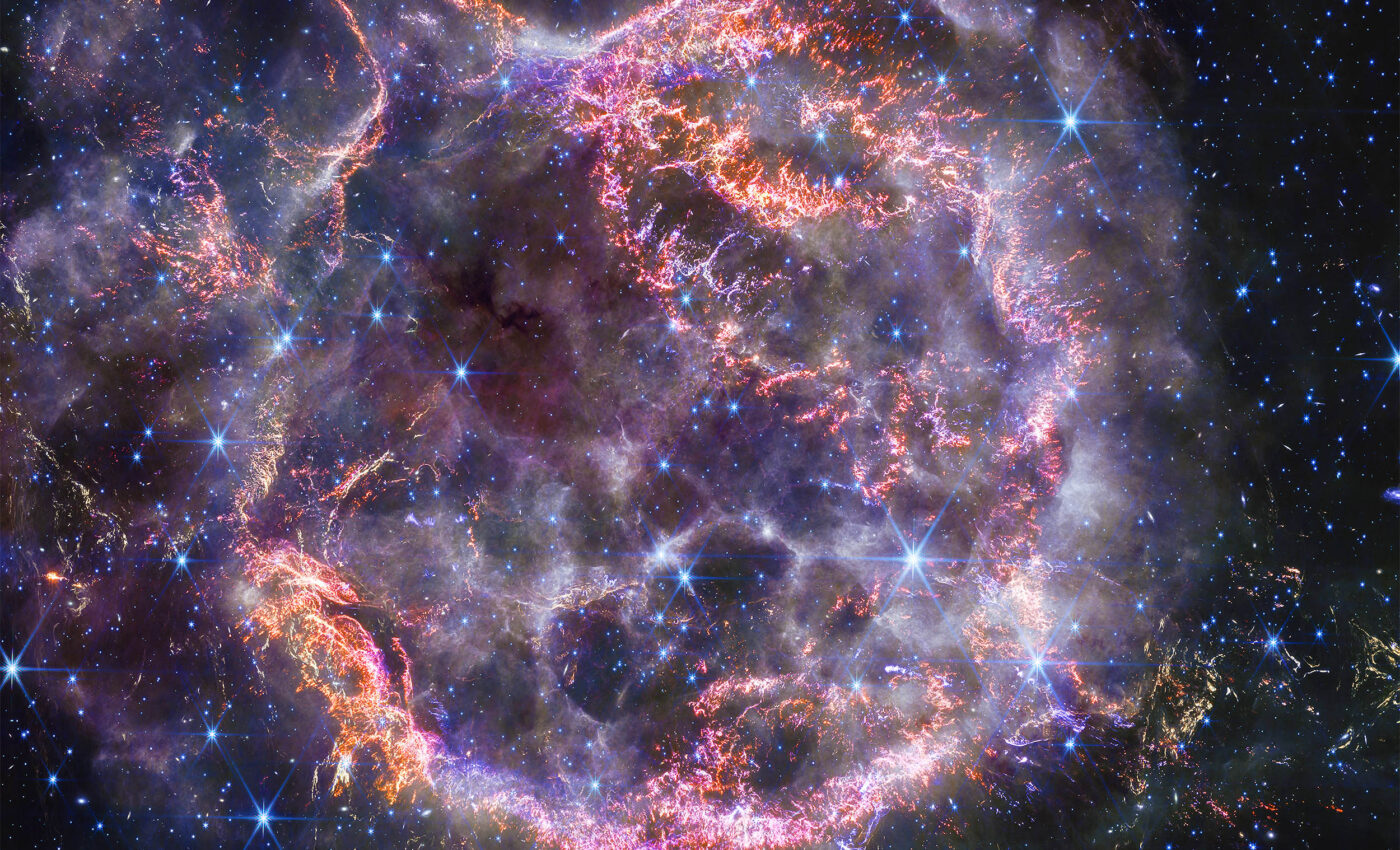
Shiny Christmas ornament in space: The "Cassiopeia A" supernova
Using the powerful NASA/ESA/CSA James Webb Space Telescope, astronomers have captured a dazzling image of the supernova remnant Cassiopeia A (Cas A), providing new insights into the violent explosion that occurred centuries ago.
The image, taken by the Near-Infrared Camera (NIRCam) of the Webb telescope, offers an unprecedented resolution and reveals intricate details of the expanding shell of material colliding with the gas ejected by the star prior to its explosion.
This high-resolution view showcases the violent nature of the explosion, which was previously out of reach to astronomers studying Cas A at these wavelengths.
Cassiopeia A is well-studied
Cas A is among the most extensively studied supernova remnants in existence. Through the combined efforts of ground-based and space-based observatories, including the iconic NASA/ESA Hubble Space Telescope, astronomers have gradually assembled a multiwavelength understanding of the remnants left behind by this cataclysmic event.
With the advent of the Mid-Infrared Instrument (MIRI) on the Webb telescope in April 2023, scientists have entered a new phase of studying Cas A.
The MIRI has uncovered unexpected features within the inner shell of the supernova remnant. However, many of these intriguing features remain invisible in the new NIRCam image, prompting astronomers to investigate the reasons behind this discrepancy.
Decoding invisible infrared light
Given that infrared light is invisible to the human eye, scientists use visible colors to represent these wavelengths. In this latest image of Cassiopeia A, colors have been assigned to the different filters of NIRCam, each color hinting at distinct activities occurring within the object.
Although the NIRCam image may appear less colorful than the MIRI image, the difference lies in the specific wavelengths emitted by the material in the object.
Prominently featured in the new image are clumps of bright orange and light pink, constituting the inner shell of the Cas A supernova remnant. The exceptional resolution of the Webb telescope enables the detection of minute gas knots composed of sulfur, oxygen, argon, and neon originating from the star itself.
Embedded within this gas are dust particles and molecules that will eventually play a crucial role in the formation of new stars and planetary systems.
Mysteries lie within the infrared spectrum
When compring the new near-infrared view of Cas A with the mid-infrared view, the inner cavity and outermost shell appear devoid of color in the former. The deep orange and red hues observed in the MIRI image transform into smoky shades reminiscent of a campfire in the NIRCam image.
This transformation occurs due to the supernova blast wave colliding with the surrounding circumstellar material. The dust within this material emits light in the mid-infrared but remains undetectable at near-infrared wavelengths.
According to researchers, the white color seen in the NIRCam image originates from synchrotron radiation generated by charged particles moving at exceptionally high speeds along magnetic field lines.
This type of radiation is visible not only in the bubble-like shells within the lower half of the inner cavity but also in the white and purple outlines surrounding the circular holes in the MIRI image. These holes represent ionized gas sculpted and pushed through by the supernova debris.
The ‘Green Monster’ and Baby Cas A
The NIRCam image does not reveal the loop of green light observed within the central cavity of Cassiopeia A in the mid-infrared view. This distinctive feature, aptly named the Green Monster by the research team, poses a significant challenge to researchers seeking to understand its nature.
Nevertheless, the near-infrared remnants in this region provide valuable insights. The circular holes visible in the MIRI image, faintly outlined in white and purple emission in the NIRCam image, are believed to result from the supernova debris interacting with the gas left behind by the star’s explosion.
In the bottom right corner of NIRCam’s field of view, researchers were astonished to uncover a large, striated blob, resembling an offspring of the main supernova – an echo of light known as Baby Cas A. This striking feature arises from the long-ago explosion of the star, which has now reached and heated distant dust, causing it to emit a glow as it cools down.
The intricate dust pattern in this light echo, coupled with Baby Cas A’s seemingly close proximity to the supernova remnant itself, presents an intriguing puzzle for scientists. Remarkably, Baby Cas A is situated roughly 170 light-years behind the main supernova remnant.
Captivating portrait of light echoes
Webb’s new image of Cassiopeia A also includes several smaller light echoes scattered throughout the composition, further enriching our understanding of the dynamics within the remnant.
The Cas A supernova remnant resides approximately 11,000 light-years away in the constellation Cassiopeia. This cataclysmic event, estimated to have occurred about 340 years ago from our perspective, continues to captivate scientists and inspire new avenues of exploration.
—–
Like what you read? Subscribe to our newsletter for engaging articles, exclusive content, and the latest updates.
Check us out on EarthSnap, a free app brought to you by Eric Ralls and Earth.com.
—–













